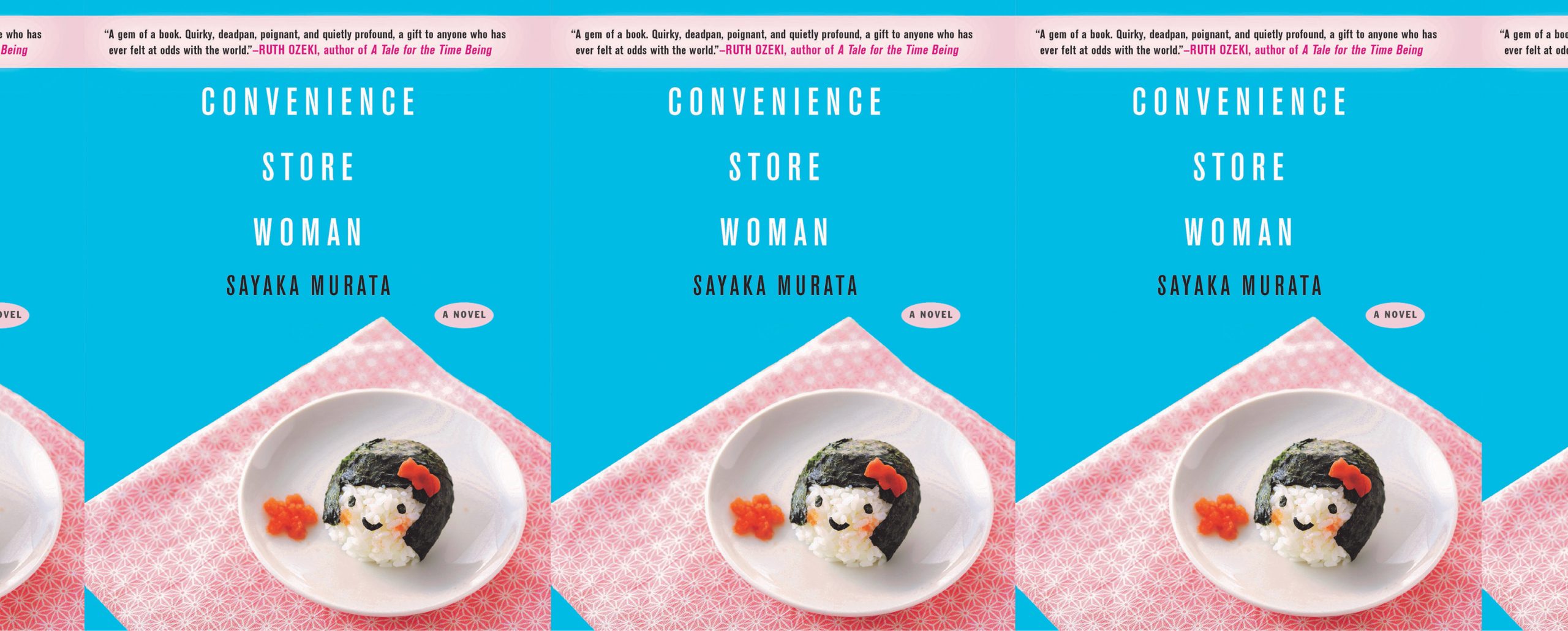The Biopolitical Body of Convenience Store Woman

Coined by Michel Foucault, “biopower” is a term used to describe the ways in which the human body is subjugated and controlled by the state. In Sayaka Murata’s 2016 novel, Convenience Store Woman, her main character, Keiko, a worker at a SmileMart who dedicates her whole life to her job, is an object of biopower. But the implied morality of Murata’s novel suggests that the state of bodily control to which Keiko willingly subjects herself may not be as simple as either oppression or free will. Although Amelia Brown rightly describes Keiko as “empowered” by the end of the novel, the brainwashing influence of biopower makes this empowerment faintly tragic, and sparks questions about whether escaping biopower is even possible.
Throughout the novel, Keiko presents herself as an object of the convenience store, owned by it and directed by its needs. She sees people as “cogs” in society, presenting both the world and its inhabitants as parts of a functional machine, and it is only by becoming a “cog” as part of the convenience store that Keiko values her life. Outside of work, she appears to value very little, calling food her “feed” and seeming unphased by the blandness of her diet so long as it fuels her work. She regularly excuses herself from social events in order to rest, so that she can function at her best for the store. Even on her days off, all of her actions are centered on how she can best serve the convenience store.
Along with seeing herself as a literal mechanical part of the store, which must be regularly serviced and maintained, Keiko also sees herself and those around her as akin to machines, made up of constituent parts and defined by function. Most notably, Keiko describes how the way she speaks has been altered by those around her, and she understands herself through which parts of her colleagues’ personalities she has adopted: “I am currently made up of 30 percent Mrs. Izumi, 30 percent Sugawara, 20 percent the manager, and the rest absorbed from past colleagues.” Notice here that no percentage of Keiko’s conception of herself is purely her; like a machine, no part of her is strictly her own—she is composed only of many identifiable parts, each easily replaced. According to her, there is no Keiko; the creature known as “Keiko” is merely an empty vessel, filled and directed by those around her.
Similarly, Keiko categorizes the people around her based on their function in her life. On multiple occasions, she emphasizes how, in the store, all employees are stripped of their identities and made synonymous: “Once we donned our uniforms, we were all equals regardless of gender, age, or nationality—all simply store workers.” Keiko uses this argument to dismiss her colleague Shiraha’s claims about men and women’s fundamental differences. When describing her current and previous managers, Keiko claims that, despite their distinct personality differences, which she explains in some detail, she still “sometimes [has] the feeling they are but one single creature.” As all of her managers have fulfilled the same function in her life, Keiko cannot help but see them all as different sides of the same person, just as we may see no fundamental difference between an old machine and its replacement. Similarly, when meeting her baby nephew, Keiko remarks that “there wasn’t any difference between Miho’s child and my nephew, and I didn’t see the logic of coming out all the way here just to see him,” the implication being that both babies, whom she visits out of a feeling of duty, are the same in her eyes. Both have limited function in her life, so she equates the two and sees no value in visiting them. In this way, Murata presents Keiko as someone who characterizes the people around her and herself as machines: people are categorized in her eyes by their function, and Keiko herself is defined by her constituent parts, with no “self” beneath.
Returning to biopower, it is clear how the bodies of Convenience Store Woman’s characters, in Keiko’s mind, are its objects: their bodies have been hijacked by society, newly defined by function over more emotive features like personality. In a way, we can see Keiko’s view of the world as representative of the harsh, mechanical view biopower has of its citizens—people are “cogs” that, if not maintained or useable, must be discarded. In her 2021 book, Biopolitical Futures in Twenty-First Century Speculative Fiction, Sherryl Vint calls this perception of the worker the “vital machine,” a “not-quite-fully-human entity imagined as there to serve the aims of those privileged by economics and geography.” By becoming a “cog” in society, Keiko makes herself an object of biopower rather than a subject, as she dehumanizes herself and others to the point of machine.
What’s interesting about Convenience Store Woman in this light is the confusing morality it suggests, as despite Keiko appearing to view life from the perspective of biopower, the antagonists of the novel also impose this same control over Keiko’s body, yet they are seen to be in the wrong. The main conflict for Keiko throughout the novel is the way she wants to live her life—as a convenience store worker, dedicating her body and her life to the store—versus how her family and peers think she ought to live, namely by getting married and striving for a more professional job. Keiko’s sister sees her as broken and desperately wants her to be “cured,” at one point begging Keiko to “Please try to be normal!” As Shiraha explains, those who cannot be useful to society by getting married, having children, and making money are seen as “foreign objects” and are therefore discarded. Shiraha, too, attempts to use Keiko’s body for himself by hiding in her apartment after he is terminated and forcing her to get a better job to support them both, claiming that the arrangement is mutually beneficial.
Both Keiko’s sister and Shiraha are presented as antagonists who attempt to control and redirect Keiko’s life against her will. To make others happy, Keiko goes along with it, but eventually realizes that her position in society is not as a wife, a mother, nor a high-flying careerist, but as a convenience store woman. The moral emphasis by the end of the novel appears to be that one shouldn’t be controlled by others and should instead follow their own path in life.
This morality is confused, however, when we consider biopower, as Keiko’s life as she wishes to live it—as an agent of SmileMart, offering up her life and her body to its service—demonstrates a kind of control that, when we remember that this is the life she wants, makes her story faintly tragic. While Keiko’s peers are rightly condemned by the novel for trying to make her conform to their idea of normality, can we really support Keiko’s bodily submission to her role as a convenience store worker and the view of the world she has built as a result?
As mentioned earlier, Sherryl Vint would likely see Keiko’s conception of herself as a “vital machine,” which is necessarily made “not-quite-fully-human” and thus an object rather than a subject of biopower. Keiko not only characterizes herself as inhuman through her machine analogy, which sees humans as “cogs” defined by function, but also through descriptive language that turns an artificially constructed role—the convenience store worker—into an animal, making it natural and therefore more acceptable. Keiko likens her work to a natural state, claiming that she has developed instincts that allow her to know what the convenience store needs. She even suggests that she has an almost magical connection to the store, as when she leaves, she feels that her body is still “connected to the convenience store.” Whenever she looks at the clock, even at home, she “would think about what was happening in the convenience store.” While this is presented as a mystical connection, in reality it is a kind of brainwashing. We see early on that, when she began working at SmileMart, Keiko was given two weeks of training and a manual. Even eighteen years on, she and her co-workers still have to recite a pledge and a number of key phrases, such as the repeated greeting “Irasshaimasé!” before their shift. It is clear, then, that Keiko’s affinity with the store is not something natural at all, but at best habit and at worst corporate brainwashing. While Keiko believes that “the voice of the convenience store [flows] through me. I was born to hear this voice.” In reality, she has been conditioned to hear its voice.
Similarly, Keiko presents work as a natural state through the suggestion that the convenience store worker is a separate, non-human “creature.” Near the beginning of the book, Keiko notes how fascinating it is to watch her co-workers transform, through donning their uniforms, from their normal selves into the “homogenous being known as a convenience store worker… It was like changing costumes to become a different creature.” This suggestion, that the worker is a distinctly “different creature” to a normal human being, is brought to fruition at the end of the novel, when Keiko calls another company she was to be interviewed by “to tell them I wouldn’t be attending because I was a convenience store worker.” Here, Keiko frames her desired job not as a role but an identity: she is not cancelling because she wants to be a convenience store worker, but because she is one. Thus, the convenience store worker is a creature that one can be, even when they are not, as with Keiko in this scene, currently working at a store. This further naturalizes what is an artificial role, and therefore romanticizes Keiko’s life as a convenience store worker, concealing the troubling attitude of wanting to be “a useful tool.” The danger here is that if the convenience store worker is seen as a non-human creature perfectly suited to life at the store, it is then easy to diminish their rights as a human being.
Murata does not present a solution to this dilemma, but I feel that this is intentional. Although Keiko’s revelation at the end of the novel appears to be an attempt to reclaim control over her life, she is instead recommitting her life to the convenience store. Rather than allowing her body to be controlled by her peers, she allows her body to “belong to the convenience store” instead. What Murata exposes here are two questions: First, is it possible to escape biopower? Some biopolitical theorists think not, and Keiko’s false escape from outside control appears to suggest the same. But second, does this matter? By the end of the novel, regardless of how we might judge her decision, Keiko is happy, and as we see throughout, the fact that her “body… belong[s] to the convenience store” does not seem to bother her—if anything, it gives her meaning. Thus, the book seems to ask: is autonomy possible, and if it is, is it more important than happiness? This is not a question Murata seeks to answer, but a debate she fuels.



